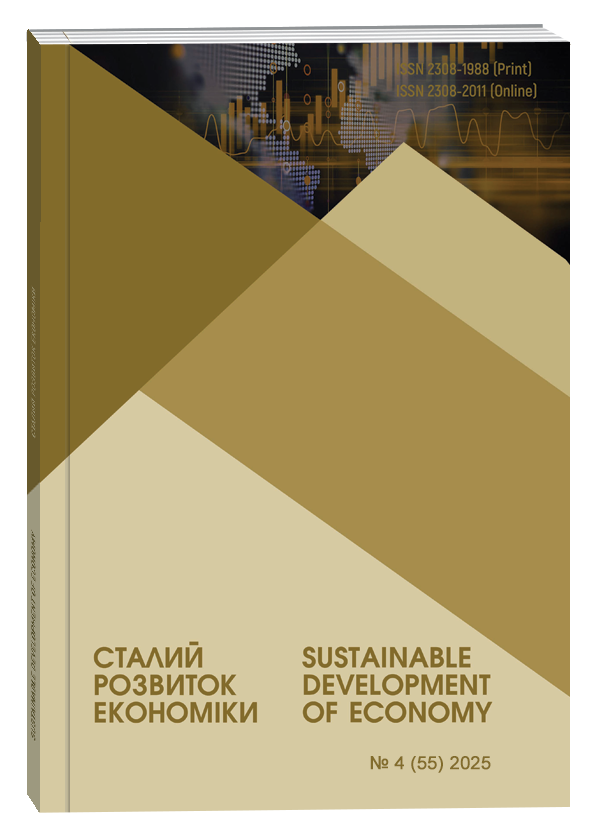COMPREHENSIVE ANALYSIS OF CIRCULAR ECONOMY DEVELOPMENT IN UKRAINE AND EU
Abstract
The article provides a comprehensive analysis of the development of the circular economy in Ukraine and the EU countries. A comparative analysis of the methods of research on the circular economy in the scientific literature showed that scientists use various sets of indicators and different methods of their generalization to study the circular economy. Due to incomplete comparability, partial absence of Ukrainian statistical data and Eurostat data, the question arises of choosing a methodology for studying indicators and constructing an integral indicator based on them. Based on the entire set of research methods, it was decided to use the Gray relational coefficient for such analysis. The Gray coefficient is part of the Gray relational analysis, developed for use in the decision-making process when data are uncertain, scarce and/or incomplete. The main idea of this study was to include the maximum possible number of variables defined by the EU, as this will allow for a comparative assessment of the effectiveness of achieving the goals of the circular economy in Ukraine and the EU member states. Thus, 16 variables were included in the study. For comparative analysis, European countries with the highest and lowest levels of development and implementation of circular economy practices were selected. The study showed that it is worth using a dynamic approach due to structural and other changes in the economy that occur over time. Thus, it was found that there is a certain synchronous change in the relational Gray coefficient in dynamics for both the countries with the best and worst indicators, as well as for Ukraine and the EU as a whole. This indicates that they have improved their circular economy measures through changes in the entire system. Among the recommendations, it is worth highlighting increasing awareness of circular economy issues; minimizing dependence on raw materials from other countries; attracting private investment in the circular economy, including foreign direct investment; unifying the regulatory framework for waste sorting with the EU; developing a coordinated approach to monitoring circular economy statistics; strengthening actions and players that measure and monitor whether the set goals of the circular economy are being achieved.
References
Державна служба статистики України. База даних. URL: https://www.ukrstat.gov.ua/ (дата звернення: 08.07.2025).
Євростат. База даних. URL: https://ec.europa.eu/eurostat/web/main/data/database (дата звернення: 05.07.2025).
Хмілевська А., Войтко С. Формування індексу циркулярної економіки для порівняльного аналізу переходу країн Європи до циркулярної економіки. Економіка та суспільство. 2021. № 32. URL: https://doi.org/10.32782/2524-0072/2021-32-58 (дата звернення: 02.07.2025).
European Commission Report, Environmental Implementation Review 2019 the EU Environmental Implementation Review 2019, Country Report - Romania. Brussels. URL: https://eur-lex.europa.eu/legal-content/EN/TXT/?uri=celex:52018DC0656 (дата звернення: 02.07.2025).
Haas W., Krausmann F., Wiedenhofer D., Heinz M. How circular is the global economy? An assessment of material flows, waste production, and recycling in the European Union and the world in 2005. J. Ind. Ecol. 2015. №19 (5), 765e777.
Kuo Y., Yang T., Huang G.-W. The use of a grey-based Taguchi method for optimizing multi-response simulation problems. Eng. Optim. 2008. № 40(6), 517e528.
Liu S., Yang Y., Forrest J. Grey Data Analysis: Methods, Models and Applications. Singapore: Springer Science & Business Media, 2016
Mitrovic D., Veselino M. Measuring countries competitiveness in circular economy - composite index approach. Quantitative Models in Economics. Beograd : University of Belgrade, Faculty of Economics Publishing Centre. 2018. P. 417-436
Steliac N., Steliac D. What is the progress of EU circular economies? Ecoforum. 2019. №8(2), 1e9.
Tsai W.-H., Lee H.-L., Yang C.-H., Huang C.-C. Input-output analysis for sustainability by using DEA method: a comparison study between European and Asian countries. Sustainability. 2016. №8(12), 1e17.
Vuta M., Enciu A., Cioaca S.I. Assessment of the circular economy’s impact in the EU economic growth. Amfiteatru Economic. 2018. №20(48), 248e261.
Derzhavna sluzhba statystyky Ukrainy. Baza danykh [State Statistics Service of Ukraine. Database]. Available at: https://www.ukrstat.gov.ua/ (access date: 08.07.2025). (in Ukrainian)
Ievrostat. Baza danykh [Eurostat. Database]. Available at: https://ec.europa.eu/eurostat/web/main/data/database (access date: 05.07.2025). (in English)
Khmilevska A., Voitko S. (2021). Formuvannia indeksu tsyrkuliarnoi ekonomiky dlia porivnialnoho analizu perekhodu krain Yevropy do tsyrkuliarnoi ekonomiky [Formation of the circular economy index for comparative analysis of the transition of European countries to a circular economy]. Ekonomika ta suspilstvo - Economy and Society, no. 32. DOI: https://doi.org/10.32782/2524-0072/2021-32-58 (access date: 02.07.2025). (in Ukrainian)
European Commission. Report, Environmental Implementation Review 2019 the EU Environmental Implementation Review 2019, Country Report - Romania. Brussels. Available at: https://eur-lex.europa.eu/legal-content/EN/TXT/?uri=celex:52018DC0656 (access date: 02.07.2025).
Haas W., Krausmann F., Wiedenhofer D., Heinz M. (2015). How circular is the global economy? An assessment of material flows, waste production, and recycling in the European Union and the world in 2005. J. Ind. Ecol, vol. 19 (5), 765e777.
Kuo Y., Yang T., Huang G.-W. (2008). The use of a grey-based Taguchi method for optimizing multi-response simulation problems. Eng. Optim, vol. 40(6), 517e528.
Liu S., Yang Y., Forrest J. (2016). Grey Data Analysis: Methods, Models and Applications. Singapore: Springer Science & Business Media.
Mitrovic D., Veselino M. (2018). Measuring countries competitiveness in circular economy - composite index approach. Quantitative Models in Economics. Beograd: University of Belgrade, Faculty of Economics Publishing Centre, pp. 417-436.
Steliac N., Steliac D. (2019). What is the progress of EU circular economies? Ecoforum, vol. 8(2), 1e9.
Tsai W.-H., Lee H.-L., Yang C.-H., Huang C.-C. (2016). Input-output analysis for sustainability by using DEA method: a comparison study between European and Asian countries. Sustainability, vol. 8(12), 1e17.
Vuta M., Enciu A., Cioaca S.I. (2018). Assessment of the circular economy’s impact in the EU economic growth. Amfiteatru Economic, vol. 20(48), 248e261.


